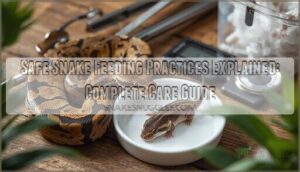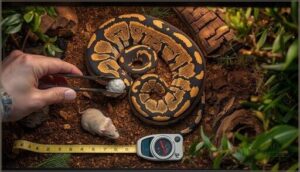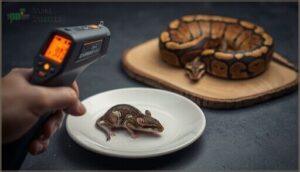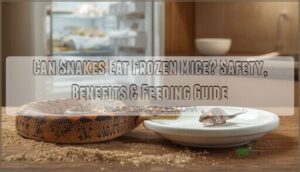This site is supported by our readers. We may earn a commission, at no cost to you, if you purchase through links.
A single feeding mistake can mean the difference between a thriving snake and a trip to the emergency vet. Many new snake owners don’t realize that improper prey size causes regurgitation, or that live rodents can seriously injure their pet.
Safe snake feeding practices, explained through proper protocols, protect both you and your snake from preventable complications. Understanding species-specific dietary needs, mastering thawing techniques, and maintaining strict hygiene standards form the foundation of responsible snake care.
Your feeding approach directly impacts your snake’s immune function, growth rate, and lifespan. Getting these fundamentals right from day one sets you up for years of successful reptile keeping.
Table Of Contents
- Key Takeaways
- Understanding Snake Dietary Needs by Species
- Choosing The Right Prey Size and Type
- Frozen Vs. Live Prey: Safety Practices
- How to Properly Thaw and Prepare Prey
- Feeding Frequency Based on Snake Age
- Safe Feeding Techniques and Handling Tips
- Hygiene and Sanitation for Snake Feeding
- Monitoring Snake Health and Feeding Response
- Frequently Asked Questions (FAQs)
- Conclusion
Key Takeaways
- Matching prey size to your snake’s body width (or up to 1.5 times wider) prevents the regurgitation and injury that cause over 40% of feeding-related deaths, making proper sizing a non-negotiable safety standard.
- Frozen-thawed prey eliminates 100% of bite injuries from defensive rodents and drastically cuts parasite transmission compared to live feeding, while maintaining full nutritional value when thawed correctly in warm water.
- Feeding frequency must shift with age—hatchlings need meals every 5-7 days for rapid growth, juveniles every 7-10 days, and adults only every 10-14 days due to their dramatically slower metabolism.
- Strict hygiene protocols including sanitizing equipment between uses, immediate waste removal, and thorough handwashing before and after feeding protect against Salmonella and other pathogens that snakes carry at rates up to 56%.
Understanding Snake Dietary Needs by Species
Not all snakes eat the same thing, and getting the diet right starts with knowing what your species naturally hunts in the wild. Some thrive on rodents, others need fish or amphibians, and a few have truly unusual requirements.
Let’s break down the main dietary categories so you can match your snake’s meals to its biology.
Rodent-Eating Snakes (Ball Pythons, Corn Snakes)
Ball pythons and corn snakes thrive on rodent-based diets, requiring prey rich in protein and essential nutrients. In the wild, corn snakes consume mice, rats, birds, and bats, but your captive snake feeding safety relies on quality frozen rodents. Ball pythons need prey containing 60-70% water content.
Monitor your snake’s health by selecting prey matching body width, ensuring proper reptile nutrition and snake behavior responses. For peak health, understanding corn snake feeding is key for their development.
Fish and Amphibian Feeders (Garter Snakes)
Unlike rodent feeders, garter snakes present unique feeding challenges. Their carnivorous appetites lean toward fish and amphibians—but be cautious. Fish like goldfish contain thiaminase, destroying essential B1 and causing neurological issues. You’ll need to rotate prey types carefully:
- Choose safer fish options: tilapia, cod, or salmon with lower thiaminase levels
- Freeze fish at -18°C for 7-10 days to reduce parasite transmission risks
- Supplement diets with earthworms to maintain proper reptile nutrition and prevent deficiencies
- Avoid wild-caught amphibians that may carry harmful toxins or pathogens
Proper prey variation protects your garter snake’s health long-term. Understanding neurological garter snake health is essential for preventing thiamine deficiency.
Specialized Diets (Egg-Eating Snakes)
Egg-eating snakes (genus Dasypeltis) take specialized diets to another level—they won’t touch rodents or fish. These carnivorous specialists consume only bird eggs.
Offer 1-2 eggs weekly at room temperature, ensuring they’re no larger than three times the snake’s head size. Quail, finch, and canary eggs provide dietary variety that aids snake nutrition and metabolism.
Place eggs inside the enclosure rather than using feeding techniques with tongs. This reptile care approach respects their natural behavior while maintaining snake feeding safety and proper egg size selection.
Essential Nutrients (Calcium, Vitamin D3, Protein)
Beyond choosing the right prey type, you need to understand the nutritional building blocks that keep your snake thriving. Calcium and vitamin D3 work together—whole prey items deliver about 5.5% calcium on a dry matter basis, while UVB exposure can boost vitamin D3 levels by over 500%.
Protein requirements sit around 52% for growing juveniles. Varied prey prevents deficiencies and bolsters long-term reptile nutrition.
Choosing The Right Prey Size and Type
Getting the prey size right isn’t just about what your snake can swallow—it’s about what it can digest safely. Too big, and you’re looking at regurgitation or worse; too small, and your snake won’t get the nutrition it needs to thrive.
Let’s break down how to match prey to your snake’s specific needs.
Matching Prey to Snake’s Body Width
Getting prey size guidelines right hinges on one simple measurement: your snake’s widest body segment. Match prey to that width—or up to 1.5 times it for most species—and you’ll support healthy feeding safety and proper body width ratio.
This snake anatomy principle prevents regurgitation and injury. Measure girth before each prey selection, and you’ll master reptile nutrition without guesswork.
Age-Appropriate Prey Selection (Hatchlings to Adults)
Your snake’s feeding stages shift dramatically as they grow. Hatchlings need pinky mice—1 to 3 grams—every 5 to 7 days to fuel rapid growth rates and meet early nutrient requirements.
Juveniles shift to fuzzy mice at 5 to 8 grams, fed every 7 to 10 days.
Adults handle mature rats or mice weighing 20 to 150 grams, fed every 14 to 21 days, aligning prey size guidelines with snake development and reptile nutrition needs.
Risks of Oversized Prey
Oversized prey items account for 40.6% of feeding-related snake mortality. When you push past your snake’s gape limits, you’re inviting regurgitation causes, gastrointestinal risks, and feeding injuries.
Oversized prey causes over 40% of feeding deaths—respecting your snake’s gape limits isn’t optional, it’s lifesaving
Prey size limits aren’t arbitrary—they protect digestive function and prevent mechanical trauma. Snake feeding safety depends on staying within 1 to 1.5 times body diameter.
Pushing boundaries compromises snake health and elevates snake mortality rates unnecessarily.
Species-Appropriate Prey Options
Prey variety isn’t just about availability—it’s about matching dietary needs to natural feeding practices. Ball pythons and corn snakes thrive on rodent-based diets, with over 90% maintained on mice and rats.
Garter snakes need fish, earthworms, and amphibians. African egg-eaters require quail eggs exclusively.
Each prey alternative delivers specific reptile nutrition profiles that support snake health when properly sized.
Frozen Vs. Live Prey: Safety Practices
One of the biggest decisions you’ll make as a snake keeper is whether to feed frozen-thawed or live prey. Each option comes with its own safety considerations, and understanding the differences helps you protect both your snake and yourself.
Let’s look at what makes frozen prey the safer choice for most situations, how to source quality feeders, and why live prey can pose real risks.
Benefits of Frozen-Thawed Prey
When you compare frozen-thawed prey to live options, the advantages are striking. You’ll see dramatic improvements in snake feeding safety, parasite control, and disease prevention—studies show frozen prey eliminates 100% of bite injuries that occur during live feeding.
Your snake’s health benefits from nutrient retention during proper storage, while you gain feeding convenience and cost savings through bulk purchasing.
| Safety Benefit | Measurable Impact |
|---|---|
| Injury elimination | 84% fewer vet visits |
| Parasite reduction | 94% infection-free after one year |
| Hygiene improvement | 28% less cleaning required |
Frozen-thawed prey promotes superior reptile nutrition while simplifying your feeding practices considerably.
Ethical Sourcing and Quality Standards
When you’re selecting frozen prey, you’re making a choice that goes beyond convenience—you’re promoting your snake’s long-term well-being. Quality assurance begins with sustainable breeding facilities that follow welfare certifications and pathogen testing protocols. Transparency labels now reveal everything from nutritional profiles to health screening results, helping you prioritize both animal welfare and reptile nutrition.
Here’s what certified suppliers deliver:
| Standard Type | What It Ensures | Your Benefit |
|---|---|---|
| Welfare Certifications | Humane treatment protocols | Promotes ethical animal welfare practices |
| Pathogen Testing (PCR) | Salmonella/Listeria screening | Protects snake health from infections |
| GMP/ISO 22000 | Food safety compliance | Guarantees consistent animal nutrition quality |
| USDA/CITES Documentation | Legal, traceable sourcing | Verifies sustainable breeding origins |
| QR Code Labels | Batch-specific health data | Facilitates informed hygiene practices decisions |
Look for suppliers publishing laboratory results—transparency signals commitment to your snake’s health and responsible reptile care standards.
Risks of Live Prey Feeding
While quality standards protect your snake, live prey introduces hazards that frozen options eliminate. Live rodents defend themselves—biting, scratching, and causing trauma that accounts for 20% of emergency exotic vet visits. You’re also risking pathogen transmission, stress-induced feeding refusals, and regurgitation.
Here’s what the data reveals about live prey risks:
| Risk Category | Documented Impact | Your Snake’s Consequence |
|---|---|---|
| Feeding Injuries | 30% bite wound rate | Secondary infections, blindness |
| Pathogen Transmission | 23% bacterial infection increase | Compromised immune function |
| Stress Impacts | 36% cortisol elevation | Defensive aggression, feeding refusal |
| Regurgitation Causes | 32% higher occurrence | Nutrient loss, dehydration |
| Health Monitoring | 29% require vet intervention | Increased care costs, trauma |
Live prey feeding techniques sacrifice snake feeding safety for unnecessary risk.
How to Properly Thaw and Prepare Prey
Thawing frozen prey correctly makes all the difference between a safe meal and a health risk for your snake. The process isn’t complicated, but cutting corners can lead to bacterial contamination or nutritional loss.
Here’s what you need to know to prepare prey safely every time.
Safe Thawing Methods (Warm Water Technique)
The warm water technique stands as your safest bet for thawing frozen-thawed prey while maintaining snake health and bacterial control. Keep thawing temperatures around 37°C (98.6°F) to protect thermal safety and prey handling integrity.
Follow these snake feeding techniques for proper snake feeding safety:
- Submerge prey in warm water for 30–45 minutes, checking for cold spots
- Use leak-proof bags to maintain water quality and prevent contamination
- Replace water every 15 minutes to control bacterial growth during your feeding schedule
Avoiding Microwave Use
While warm water works perfectly, you might be tempted to speed things up with your microwave—but don’t. Microwave risks include uneven heating that creates internal hot spots reaching 60°C while surfaces stay cool, threatening thermal burns to your snake’s mouth. You’ll also face nutrient loss (vitamin B6 drops 35%, taurine 28%) and bacterial growth in cold spots, compromising both snake feeding safety and snake health with frozen-thawed prey.
| Microwave Risk | Impact on Snake Care |
|---|---|
| Uneven heating creates hot spots | Oral burns, feeding aversion |
| Vitamin degradation (B6, A, E) | Nutritional deficiencies over time |
| Amino acid breakdown | Reduced protein quality |
| Cold spots enable bacteria | Salmonella persistence, illness risk |
| Kitchen cross-contamination | Zoonotic disease transmission |
Safe thawing protects feeding safety.
Checking Prey Temperature Before Feeding
Once you’ve thawed the prey, don’t skip checking its temperature—your snake’s feeding response depends on thermal safety. Use an infrared thermometer to verify 98–100°F before offering frozen-thawed prey. Ball pythons show 33% higher acceptance rates at proper temperatures, while cold prey below 95°F triggers refusal and slows digestion optimization, compromising your snake feeding safety and overall snake care routine.
Temperature measurement protects your feeding schedule:
- Infrared guns give instant, non-contact readings you can trust
- Digital probe thermometers confirm internal warmth matches surface heat
- Cold prey below 88°F causes 45% fasting rates in hatchlings
- Overheated prey above 100°F risks oral burns and feeding aversion
- Proper prey temperature control prevents regurgitation and metabolic stress
Preventing Bacterial Growth During Thawing
Bacterial risk multiplies fast when you ignore temperature control—keep thawed rodents below 40°F to stop pathogens. Refrigeration safety means thawing frozen-thawed prey overnight in sealed bags, never at room temperature where bacteria double every 20 minutes.
Your sanitation protocols and proper thawing methods protect your snake feeding techniques and feeding schedule, preventing Salmonella exposure in your reptile care and nutrition routine through strict hygiene and sanitation practices with frozen prey handling.
Feeding Frequency Based on Snake Age
Getting the feeding schedule right is one of those things that can make or break your snake’s health. Young snakes have fast metabolisms and need frequent meals to fuel their rapid growth, while adults can go much longer between feedings without any issues.
Let’s break down exactly how often you should feed your snake at each life stage.
Hatchling Feeding Schedule (Every 5-7 Days)
Your hatchling’s first months are all about building a foundation for lifelong health through proper feeding intervals. During this critical development stage, you’ll feed every 5-7 days to support rapid growth rates and meet their intense caloric needs.
Here’s your hatchling nutrition protocol:
- Offer a single prey item (pinky mouse, 10-15% of body weight) every 5-7 days
- Track weekly weight to confirm steady growth and feeding response
- Expect monthly shedding cycles as a sign of healthy development
- Watch for regurgitation if you feed more frequently than 5 days
- Maintain this feeding schedule until your snake reaches 100 grams
Juvenile Feeding Guidelines (Every 7-10 Days)
Once your juvenile hits the 100-gram mark, you’ll shift to feeding every 7-10 days to match their moderate growth rates. This feeding frequency prevents common feeding errors while meeting evolving nutrient needs during snake development.
Offer prey weighing 10-15% of body weight, tracking how dietary adjustments affect your pet snake health and wellness. Your snake habitat conditions must support proper digestion between feedings according to this snake feeding guide.
Adult Snake Feeding (Every 10-14 Days)
Your adult snake’s metabolism shifts into energy conservation mode, dropping to roughly 20-30% of what mammals need. That’s why feeding frequency drops to every 10-14 days—matching their slower digestion rates and nutrient utilization patterns.
This snake feeding guide interval promotes ideal reptile nutrition without triggering obesity. Studies confirm 96% of adults maintain healthy weight on these feeding cycles, with their natural energy storage systems handling the gaps efficiently.
Adjusting Schedule Based on Activity and Appetite
Your snake’s behavior tells you everything about its dietary needs. Activity monitoring reveals hunger through increased prowling and tongue flicking—signals that warrant feeding frequency adjustments.
Spring brings 30% higher appetite due to metabolic rates surging with warmer temperatures. Watch for appetite cues like heightened enclosure interaction, then modify your feeding schedule accordingly.
Digestion patterns shift with environmental changes, making flexible feeding triggers essential for meeting true feeding habits.
Safe Feeding Techniques and Handling Tips
How you feed your snake matters just as much as what you feed them. The right techniques protect both you and your snake from injury while reducing stress during feeding time.
Let’s walk through the key practices that keep feeding sessions safe and successful.
Using Feeding Tongs Properly
Think of feeding tongs as your first line of defense—they keep you safe while respecting your pet snake’s space. Choose tongs at least 30 cm long to maintain proper distance during feeding.
Essential feeding tools practices:
- Select stainless steel tongs with textured grips to prevent prey drops
- Hold prey at your snake’s midline using gentle, lifelike movements
- Keep a 12–18 inch separation between your hand and the snake behavior
- Inspect tongs regularly for bending or rust as part of tong maintenance
- Disinfect feeding tools after every session to reduce contamination risk
These handling precautions dramatically lower bite incidents while supporting natural feeding techniques.
Post-Feeding Observation and Behavior Changes
Once you’ve set down the tongs, watch your snake closely for the first 48 to 72 hours. Post feeding stress shows up as reduced movement—activity can drop by up to 80%—and behavioral shifts toward hiding.
Your snake’s digestion patterns mean it’ll seek shelter, lower its snake activity, and become less responsive. These feeding cycles are normal. You’re witnessing snake behavior and psychology at work as it prioritizes snake health over exploration during this vulnerable feeding behavior window.
Avoiding Handling After Feeding
Now that you’ve observed those post-feeding behavioral shifts, resist the urge to handle your snake for at least 48 hours. Handling intervals matter because premature contact elevates post-feeding stress and regurgitation risk during peak digestion time.
Your snake’s vulnerability peaks when metabolic demands are highest. This waiting period isn’t optional—it’s fundamental snake care and feeding protocol that protects snake health and prevents digestive complications tied to reptile care and maintenance.
Recognizing Signs of Regurgitation Risk
While waiting protects digestion, you’ll also need to spot early warning signs that feeding errors might trigger regurgitation. Watch for digestive issues within 3–4 days post-meal—that’s when most episodes occur in documented cases of snake stress affecting pet snake health.
Your health monitoring checklist includes:
- Backward muscle contractions moving up the body
- Expelled undigested prey appearing as a complete animal
- Unusually long periods in hiding spots after feeding
- Visible distress or restless movement patterns
- Changes in normal activity levels during digestion
Temperature fluctuations and oversized prey remain top regurgitation triggers. Adjust your snake feeding approach if you see these red flags—proper reptile nutrition depends on matching feeding frequency to your snake’s tolerance.
Hygiene and Sanitation for Snake Feeding
Keeping your feeding routine clean isn’t just good practice—it’s essential for preventing disease and protecting both you and your snake. Bacteria can spread quickly through contaminated equipment, surfaces, and improper handling.
Let’s walk through the key sanitation steps that should become second nature every time you feed.
Sanitizing Feeding Equipment Between Uses
Your feeding tools carry pathogens that can threaten both you and your snake. Disinfectant types like chlorhexidine or F10SC (diluted 1:250) work best for equipment cleaning after each use. Soak tongs and utensils for at least five minutes, then rinse thoroughly.
Sanitation protocols recommended by reptile vets and herpetology experts emphasize separating tools between snakes to prevent cross-contamination—a cornerstone of sound animal husbandry and pathogen control.
Cleaning Feeding Areas After Each Session
After each feeding session, you need to remove uneaten prey and fecal matter immediately—residual waste harbors Salmonella and fungal pathogens.
Spot-clean your pet snake’s enclosure within 24 hours, then follow weekly disinfection protocols using 10% bleach or hydrogen peroxide with 10-15 minute contact time.
This sanitation approach reduces pathogen transmission by eliminating contaminated substrate before bacteria multiply, protecting both your snake care routine and household safety.
Proper Handwashing Before and After Feeding
Hand hygiene isn’t optional—snakes carry Salmonella at rates up to 56%, making thorough handwashing your frontline defense against zoonotic risks. Wash with soap before and after every feeding session, even when handling frozen prey or cleaning equipment.
Water quality matters, but soap effectiveness removes pathogens water alone can’t touch. Keep sanitizer nearby for quick touch-ups during your pet snake care routine.
Safe Waste Disposal Practices
Beyond the feeding process itself, proper waste management protects you and your environment from biohazard risks. Double-bag substrate and uneaten prey remnants before sealing them in regular trash—never flush organic material down drains. UK regulatory compliance guidelines recommend toilet disposal for wastewater only.
Store waste bins with secure lids to prevent wildlife access, supporting both environmental safety and reptile nutrition standards in responsible pet snake care.
Monitoring Snake Health and Feeding Response
Keeping your snake healthy means observing how it reacts to feeding and tracking changes over time. You’ll need to monitor weight, spot warning signs early, and know when something’s off with your snake’s diet.
Here’s what to watch for and how to adjust your approach when needed.
Tracking Weight and Body Condition
Your pet snake won’t tell you when something’s off—weight monitoring becomes your early warning system. Recording your snake’s mass every week or two creates a baseline that reveals health trends most keepers miss. Here’s how to stay ahead:
- Weigh consistently using a digital scale, logging each reading with date and recent feeding history
- Check body condition by gently palpating the spine and ribs—you should feel structure without sharp edges
- Track growth rates against feeding schedules to improve your reptile nutrition plan
- Document patterns in weight fluctuations, especially around shedding cycles when dietary needs shift
Regular body scoring paired with weight data helps you catch nutrition planning issues before they become serious snake health problems. Four measurements per month gives you enough data points to spot real trends versus normal variation in snake care routines.
Signs of Overfeeding and Obesity
Your snake’s silhouette tells the story—a rounded mid-body or sausage-like profile signals obesity risks from feeding errors affecting body condition. Overfeeding is a bigger threat to pet snake health issues than hunger.
Look for stretched skin, reduced activity, and difficult sheds as health consequences of poor nutrition balance. Adjusting feeding frequency based on dietary needs prevents these reptile nutrition problems before they compromise your snake’s wellbeing.
Recognizing Nutritional Deficiencies
Ever notice tremors, muscle twitching, or slow growth in your snake? These can be signs of Calcium Deficiency, Vitamin D3 shortfalls, or Nutrient Imbalance—a warning light for Snake Malnutrition and Dietary Disorders.
Poor Reptile Nutrition leads to real Pet Snake Health Issues, from skeletal deformities to infections. Stay alert to subtle changes for Snake Health and Wellness.
When to Adjust Feeding Frequency
Recognizing those deficiencies means you’re already watching closely. Now take it further: adjust your feeding frequency when you spot behavioral feeding cues like increased activity or persistent refusal.
Seasonal adjustments matter too—spring and summer ramp up metabolic rate and energy requirements, while winter slows everything down.
Track weight shifts, digestive health, and appetite changes to fine-tune your feeding schedule and meet true dietary needs.
Frequently Asked Questions (FAQs)
How long can a snake safely refuse food?
Like a medieval fast, healthy adult ball pythons tolerate several months without food.
However, juveniles face stricter safe fasting limits—only 1-2 weeks before weight thresholds demand attention to prevent starvation risks across snake species.
Should I feed my snake in a separate enclosure?
You don’t need a separate container. Most pet snakes feed better in their own enclosure, where they feel secure.
Just use feeding tongs and avoid handling afterward—feeding stress drops when snake care remains consistent.
What if my snake strikes but wont eat?
When your snake strikes at prey without eating, it’s often a red flag waving from improper temperatures or recent habitat changes.
Check your environmental factors—humidity, heat gradients—and reduce feeding stress through adjusted presentation timing.
Do snakes need vitamin supplements with their diet?
Most snakes fed healthy whole prey don’t need vitamin supplements—their dietary needs are met naturally. Routine calcium supplements aren’t required either.
However, fish-eating species and snakes with documented deficiencies may need targeted supplementation under veterinary guidance.
Conclusion
Mastering methods for safe snake feeding practices protects your pet from preventable trauma and illness. Your diligence with prey size, thawing protocols, and hygiene standards directly translates to stronger immunity and a longer lifespan.
Each feeding represents a choice—between shortcuts that risk regurgitation or injury, and careful preparation that builds trust with your snake. Stick to these fundamentals, and you’ll watch your reptile thrive for decades instead of scheduling emergency vet visits.

















